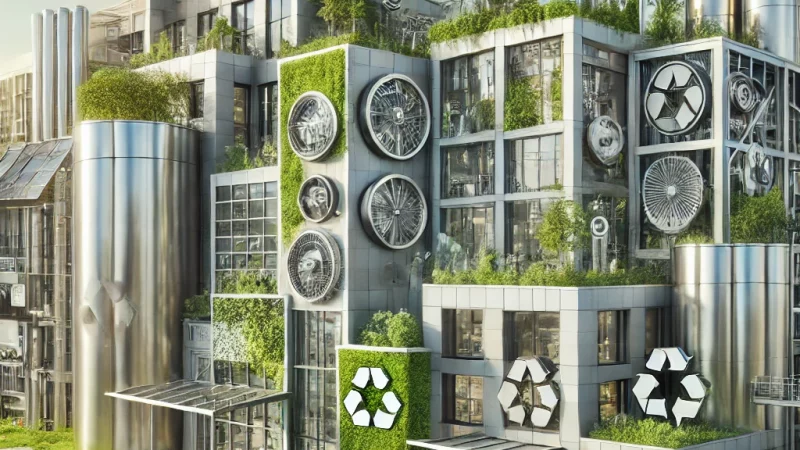Top 7 Remarkable Environmental Benefits of Stainless Steel
Stainless steel is a highly durable and sustainable material, known for its resistance to corrosion, strength, and aesthetic appeal. Beyond these functional attributes, stainless steel plays a significant role in promoting environmental sustainability and public health. In this article, we will explore the eco-friendly properties and environmental benefits of stainless steel, its applications in various industries, and how it contributes to a more sustainable future.

Stainless steel is an iron-based alloy that typically contains chromium, which gives it its unique corrosion-resistant properties. Additional alloying elements, such as nickel and molybdenum, can enhance these properties further. Stainless steel is used in a wide range of applications, from construction and automotive to medical devices and household products.
Environmental Benefits of Stainless Steel
Corrosion Resistance
One of the primary environmental benefits of stainless steel is its exceptional corrosion resistance. This property significantly extends the lifespan of stainless steel products, reducing the need for frequent replacements and conserving resources. By resisting rust and other forms of corrosion, stainless steel maintains its structural integrity and aesthetic appeal over time, minimizing waste.
Recyclability
Stainless steel is 100% recyclable, making it one of the most environmentally friendly materials available. At the end of its useful life, stainless steel products can be recycled into new products without any loss of quality. This recyclability reduces the demand for raw materials and lowers the environmental impact of mining and manufacturing processes.
Fact: According to the International Stainless Steel Forum, about 80% of stainless steel is recycled at the end of its life.
Energy Efficiency
The production of stainless steel has become increasingly energy-efficient over the years. Advances in manufacturing technology have reduced the energy required to produce stainless steel, further enhancing its sustainability. Additionally, the durability and longevity of stainless steel products mean that less energy is needed for manufacturing replacements, contributing to overall energy savings.
Safe Containment
Stainless steel’s resistance to corrosion and its non-reactive nature make it an ideal material for containing hazardous substances. It does not leach harmful chemicals into the environment, ensuring safe containment of chemicals, pharmaceuticals, and food products. This property is particularly valuable in industries where contamination could have severe environmental and health consequences.
Health Benefits of Stainless Steel
Non-Toxic and Hypoallergenic
Stainless steel is non-toxic and hypoallergenic, making it safe for use in medical devices, food preparation, and everyday products. It does not react with food or beverages, ensuring that no harmful substances are released during consumption. This safety feature is crucial for maintaining public health and hygiene.
Easy to Clean
The smooth, non-porous surface of stainless steel makes it easy to clean and disinfect. This property is especially important in medical and food preparation environments, where maintaining hygiene is critical. Stainless steel surfaces can be sterilized using common cleaning agents, reducing the risk of bacterial contamination.
Resistance to Biological Reactivity
Stainless steel does not support the growth of bacteria, fungi, or other microorganisms. This resistance to biological reactivity makes it an excellent choice for medical instruments, hospital equipment, and kitchen utensils. By preventing microbial growth, stainless steel helps maintain a sterile environment and reduces the risk of infections.
Applications of Stainless Steel in Sustainability
Construction and Architecture
In the construction industry, stainless steel is used for building facades, roofing, structural components, and decorative elements. Its durability and resistance to weathering ensure that structures maintain their integrity and appearance over time. The use of stainless steel in construction supports sustainable building practices by reducing the need for frequent maintenance and replacements.
Table 1: Benefits of Stainless Steel in Construction
| Benefit | Description |
|---|---|
| Durability | Long-lasting performance, reducing replacements |
| Corrosion Resistance | Suitable for harsh environments |
| Aesthetic Appeal | Enhances architectural design |
| Recyclability | 100% recyclable, reducing environmental impact |
Transportation
The transportation sector uses stainless steel for various components, including car exhaust systems, railway carriages, and aircraft parts. Its strength, durability, and resistance to high temperatures make it ideal for these applications. The longevity of stainless steel parts reduces the need for replacements, contributing to sustainable transportation.
Food and Beverage Industry
Stainless steel is widely used in the food and beverage industry for equipment such as tanks, pipes, and processing machinery. Its non-reactive nature ensures that it does not contaminate food or beverages, maintaining product safety and quality. Additionally, its ease of cleaning helps maintain high hygiene standards, reducing the risk of contamination and foodborne illnesses.
Medical and Healthcare
In the medical field, stainless steel is used for surgical instruments, implants, and medical devices. Its biocompatibility, corrosion resistance, and ease of sterilization make it a preferred material in healthcare settings. The use of stainless steel ensures the safety and longevity of medical equipment, supporting sustainable healthcare practices.
Water Treatment
Stainless steel is used in water treatment plants for pipes, storage tanks, and filtration systems. Its resistance to corrosion and contamination ensures the safe and efficient processing of water. Stainless steel’s durability and low maintenance requirements make it a cost-effective and sustainable choice for water infrastructure.
Promoting Sustainable Practices with Stainless Steel
Choosing Reputable Suppliers
Working with reputable stainless steel suppliers ensures access to high-quality materials that meet industry standards. These suppliers often adopt sustainable manufacturing practices, further reducing the environmental impact of stainless steel production.
Implementing Best Practices
Implementing best practices in the use and maintenance of stainless steel products can enhance their sustainability. This includes regular cleaning and inspection, using appropriate protective coatings, and recycling end-of-life products.
Supporting Green Building Initiatives
Incorporating stainless steel into green building initiatives can help achieve sustainability goals. Stainless steel’s properties align with the principles of green building, including energy efficiency, resource conservation, and durability.
Conclusion
Stainless steel is a highly sustainable and environmentally friendly material, offering numerous benefits across various industries. Its recyclability, durability, and resistance to corrosion make it an ideal choice for applications that require long-lasting and low-maintenance solutions.



